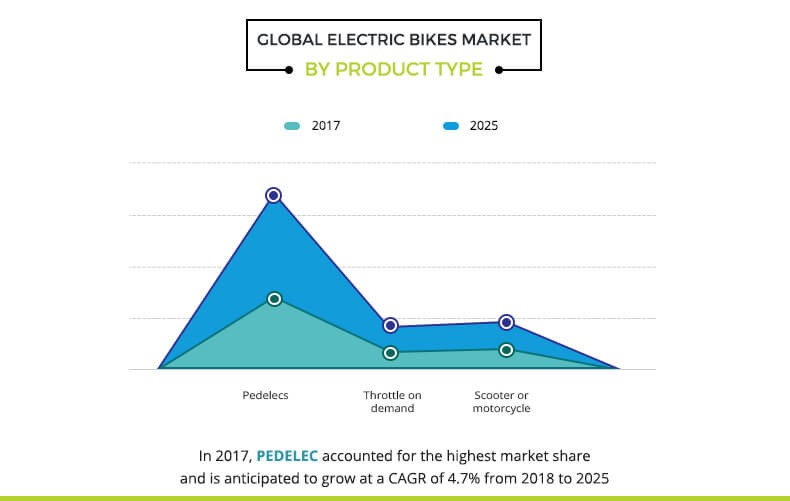According to the report, the global electric
bikes market was pegged at $17.23 billion in 2018 and is estimated to reach
$12.83 billion by 2025, registering a CAGR of 4.9% from 2018 to 2025.
We
are in professional corporate relations with various companies and this helps
us in digging out market data that helps us generate accurate research data
tables and confirms utmost accuracy in our market forecasting. Each and every
data presented in the reports published by us is extracted through primary
interviews with top officials from leading companies of domain concerned. Our
secondary data procurement methodology includes deep online and offline
research and discussion with knowledgeable professionals and analysts in the
industry.
Government support and strict rules in
favor of electric bikes, rise in costs of fuel, and growing consumer
inclination toward the use of e-bikes as they are eco-friendly items have
boosted the growth of the global electric bikes market. Moreover, the growing
interest in cycling as a fitness and recreational activity supplemented the
market. However, high cost and ban on the use of e-bikes hamper the market
growth. On the contrary, improving bicycling infrastructure and battery
technology are expected to create lucrative opportunities in the near future.
For
Purchase Inquiry: https://www.alliedmarketresearch.com/purchase-enquiry/4756
The global electric bikes market is
segmented on the basis of type, driving mechanism, battery type, and geography.
Based on type, the market is divided into pedelecs, throttle on demand, and
scooter & motorcycle. The pedelecs segment dominated the market in 2017,
contributing around two-thirds of the market. However, the throttle on demand
segment is estimated to register the fastest CAGR of 5.3% during the forecast
period.
Strict rules in favor of e-bikes, growing consumer inclination toward the use of e-bikes, and rise in interest in cycling are expected to propel the growth of the market. The pedelecs segment dominated the market in 2017, contributing around two-thirds of the market. However, the lithium-ion (Li-ion) segment is projected to register the fastest CAGR of 6.1% during the forecast period.
On the basis of driving mechanism, the
e-bikes market is bifurcated into hub motor, mid-drive, and others. The others
segment is projected to manifest the fastest CAGR of 5.8% through 2025.
However, the hub motor segment held the largest share in 2018, accounting for
nearly three-fourths of the market.
Based on battery type, the market is
categorized into lead-acid, lithium ion (Li-ion), nickel metal hydride (NiMH),
and others. The lead-acid segment held the lion’s share in 2018, contributing
more than half of the market. However, the lithium-ion (Li-ion) segment is
projected to register the fastest CAGR of 6.1% during the forecast period.
Request
for Sample Report: https://www.alliedmarketresearch.com/request-sample/4756
The electric bikes market is analyzed
across various regions such as North America, Europe, Asia-Pacific, and LAMEA. The
market across the North America region is estimated to register the fastest
CAGR of 8.7% during the study period. However, the market across Asia-Pacific held
the largest share in 2018, accounting for more than two-thirds of the market
share.
The electric bikes market report
offers an analysis of the major market players such as Accell Group, Trek
Bicycle Corporation, Derby Cycle, Fuji-ta Bicycle Co., Ltd, Jiangsu Xinri
E-Vehicle Co., Ltd., Giant Manufacturing Co., Ltd., Bionx International
Corporation, Mahindra & Mahindra Ltd. (GenZe), Tianjin Golden Wheel Group Co.,
Ltd., and Prodecotech, LLC.
About
Us:
Allied Market Research (AMR) is a
full-service market research and business-consulting wing of Allied Analytics
LLP based in Portland, Oregon. Allied Market Research provides global
enterprises as well as medium and small businesses with unmatched quality of
"Market Research Reports" and "Business Intelligence Solutions.”
AMR has a targeted view to provide business insights and consulting to assist
its clients to make strategic business decisions and achieve sustainable growth
in their respective market domain.

